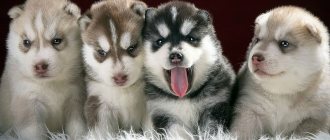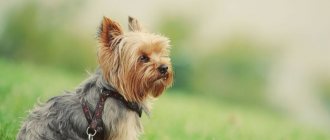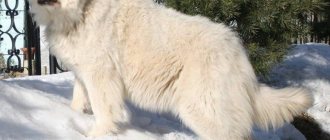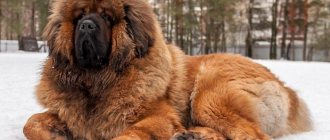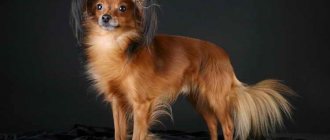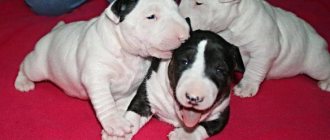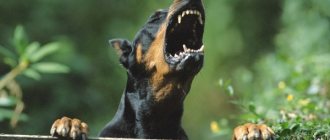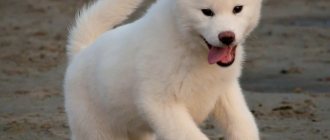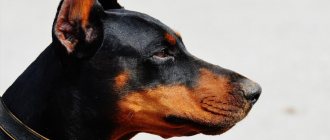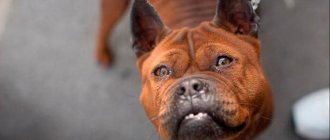History of the breed
Canada is considered the homeland of the dog, although there is evidence that in ancient times the breed belonged to the Indians. There is no exact information about who these dogs came from. According to one version, the variety was created by crossing Portuguese water dogs, mastiffs and Pyrenean shepherd dogs. This happened around the 15th-16th century.
According to another origin theory, the divers' ancestors were American black wolves and Tibetan mastiffs.
In 1775, the breed officially received a name. The definition of dogs, a description of their appearance and their systematization were given in the last years of the 19th century by the Swiss dog breeder Albert Heim.
Additional Information! Inexperienced animal lovers in Russia often confuse the name of the breed: they end up with a Newfoundler or Nyufander dog.
Newfoundland history
Canadians have put forward three versions of the origin of Newfoundlands:
- a cross between the Asian mastiff and the black wolf, which is considered extinct;
- crossing dogs or wolves from the island with Viking Bairnbury dogs;
- the appearance of crossbreeds from mastiffs, water dogs and black Scottish shepherds, which were brought to the island since the 15th century.
The American Kennel Club adds another version about Great Pyrenees dogs brought by Basque fishermen.
In our country, biologist Akimushkin I. I. added several versions of the origin of the breed:
- representatives of the breed are not a cross between local dogs and Viking mastiffs, but their wild variety;
- perhaps Newfoundlands are descendants of local huskies;
- or English Molossians.
The first dogs exported were black and white, this is exactly the type of Newfoundland that was depicted by the English artist Sir Edwin Landseer in the painting “A Worthy Member of the Humane Society,” 1838. Subsequently, this color was named in his honor.
Then English breeders took up the breed, and this is how the Black Newfie appeared.
Representatives of the breed appeared in Russia at the beginning of the 20th century. But because of their good disposition they were not very popular. The army kennel “Red Star” made an attempt to “improve” the working qualities of the Newfoundland; for this purpose, matings were made with German and Caucasian shepherds. But it was not possible to establish a clear standard, so the Moscow Diver remained at the experimental level.
Nowadays, the breed has begun to enjoy popularity, thanks to the development of the sports discipline - rescuing drowning people . This is where the Newfoundland can open up and show itself in all its glory.
Characteristics of divers
The breed is quite popular. Many would like to have such a pet, but you need to know that this is not an ordinary dog. It has many advantages and disadvantages, and there are also some peculiarities of caring for it.
The animal will not be comfortable in a hot climate; with such thick fur, Russian snowy winters are more suitable for her.
Pros and cons of the breed
The Newfoundland Diver dog has its own advantages that make it popular all over the world:
- Absolute devotion to his master.
- Excellent qualities as a watchman and security guard.
- Lack of tendency to aggression.
- Ease and speed of socialization.
- Good, friendly attitude towards household members, especially children.
Disadvantages of the breed:
- the need for careful and regular grooming;
- tendency to joint diseases and obesity;
- waywardness and the desire to make decisions independently are qualities inherent in male dogs.
Additional Information! A diver is a dog who knows how to save people. And he does this both on land and on water.
Character and psychological portrait
Behind the formidable appearance hides a subtle and vulnerable nature. Newfoundlands are very good-natured and sensitive. They do not accept criticism. Quite often they show stubbornness and independence. Inside this seemingly menacing and angry dog is a small, restless puppy who is distinguished by affection and kindness.
Newfies quickly and firmly bond with all family members, so they have a hard time dealing with long separations and changes of owners. They get along well with other animals in the house and do not show aggression towards them. They can even make friends with dogs of miniature breeds. Moreover, having adapted to the house, they become so peaceful that cats stop being afraid of them and can sleep, climbing on the backs of warm fluffy dogs.
Newfoundlands are capable of loud, frightening barks, but they rarely speak, and people around them are often afraid to approach them due to their impressive size. Divers, in turn, are very friendly towards strangers.
These animals are so imbued with love for the family that contains them that they begin to patiently protect mischievous kids. Newfoundlands love to participate in the games of older children and are happy to accompany them on various trips, ensuring the safety of their “charges.”
A massive and menacing-looking Newfoundland diver is not at all suitable for the role of a guard of a personal territory or as a hunting dog. When the first representatives of the breed began to populate the island, there was no one to hunt there, and the local population lived mainly by fishing. Accordingly, people did not need dogs with hunting skills. Friendliness and loyalty, along with an easy-going character, were much more valued.
Residents of the island of Newfoundland deserve special gratitude for the development in dogs of such qualities as the ability to make decisions and extraordinary intelligence. Fishermen needed a full-fledged companion, capable of such assistance as:
- cargo delivery;
- babysitting;
- guide in darkness and fog.
Only those animals that met the above requirements underwent natural selection. As a result, we are observing a Newfoundland diver who, although not entirely obedient, is able to quickly react in an emergency situation and make the only correct decision.
Standard
If you want to buy a Newfoundland puppy, you need to know what the dog looks like, what features it has in appearance according to the standard, so as not to be deceived. Especially if the animal is purchased not from a nursery, but from private hands. A description of the Newfoundland dog is given below.
Head
The Newfoundland's head is characterized as follows:
- heavy, very large;
- the skull is wide, the arch of the forehead protrudes slightly forward;
- the bump on the back of the head is clearly visible;
- The muzzle is short and square in shape.
The muzzle is covered with short hair, very soft to the touch.
Jaws and teeth
The dog's jaws are powerful. The teeth are large, the fangs are large and pronounced. The bite shape is scissor or straight.
The dog's teeth are pure white.
Nose
The nostrils of the nose are clearly defined. The color of the lobe depends on the base color. In dogs of a purely dark color or interspersed with a white tint, the lobe is dark, in the brown Newfoundland - to match the color of the coat.
Eyes
The diver's eyes are small, his seat is deep and wide. The eye color of dogs with dark coat color or white Newfoundlands with dark patches is deep brown, while with brown coat there is a light tone in the eye color.
Attention! In a healthy, purebred dog, the eyelids should not hang over the eyes or expose the red conjunctiva.
Ears
The ears are medium, located closer to the back of the head. The shape is triangular, the tips are rounded. If you pull an adult dog's ear forward, its tip should reach the eyes.
Neck
The Newfoundland is a dog with a powerful, thick neck, on which the muscles are well developed. The length is average, but sufficient for the head to be held majestically.
Frame
The body is strong, deep, and the muscular corset is well developed. The chest is voluminous. The back line is straight, the croup and withers are clearly defined. Males are more powerful and larger than females. The weight of males is about 68 kg, females - up to 54 kg. Height at withers is from 66 to 71 cm.
Limbs
A purebred Newfoundland's paws must meet the following standards:
- The forelimbs are straight. When walking slowly, the paws are parallel to each other. The shoulders, with well-developed muscles, are slightly leaned forward.
- The hind legs are powerful, with expressive, strong thigh muscles.
- The feet are proportional to the body. The shape is round.
- The fingers fit tightly together and are connected by membranes. Dark colored claws.
Attention! If the Newfoundland has dewclaws, they must be removed.
Tail
The tail is wide and thick. If the dog is standing, the tail is slightly lowered. When a diver swims, he acts as a rudder.
Wool
The animal's fur has the following characteristics:
- rigid structure;
- thick;
- smooth;
- not getting wet;
- oily.
The undercoat is soft and very dense; in winter it thickens even more.
Color
The classic coat color is deep, dark, like a raven's wing. When burned, brown tints may appear in it. Colors such as chocolate and bronze are allowed.
This is one of the most popular coat colors
Disqualifying faults
Features of appearance that do not correspond to a pure breed:
- Lightweight body structure, which makes the entire physique seem loose.
- The muzzle is elongated or sharp.
- Large eyes, or protruding. Yellow eye color, visible conjunctiva.
- High paws.
- The tail is too short or very long, broken in shape.
- Mincing gait.
Additional Information! A disqualifying feature is crossing your legs while walking.
Newfoundland character
The shaggy bear cub has a good disposition. It is written above that representatives of the breed do not have aggression, they are very affectionate and devoted to their owners.
When getting such a dog, you should take into account his good nature. The Newfoundland is not suitable for protection; its calling is to take care of people and help them in emergency situations. Representatives of the breed consider people their friends; growling or biting is nonsense for them. Dogs are unlikely to allow themselves such an attitude towards a person.
Newfoundlands are well trained, but will not tolerate tactless and rude treatment. Dogs tend to make decisions on their own when the situation demands it. If an animal believes that it is necessary to act in a specific way, it will ignore the command given by the owner.
The peculiarity of Newfoundlands is their good nature and patience. Representatives of the breed seem to be insensitive to pain and are able to endure it for a long time. This does not mean that the pet will adequately respond to mechanical impact (hitting or tugging) from the owner.
Attitude towards others and children
Newfoundlands are unique dogs. They are so humane that it becomes funny. Representatives of the breed are ready to meet every passerby who turns their attention to them. But people get scared when a huge dog with an open mouth rushes towards them. The Newfoundland can only be perplexed, running up to the stranger, why he froze in place and closed his eyes in horror. The dog is friendly, she wants only one thing - to lick the stranger from head to toe, smiling welcomingly and wagging her tail.
An ideal nanny for children, you can safely entrust a child to a representative of the breed. Newfoundlands take care of babies, protect them from environmental hazards, play and entertain them. But parents need to monitor the dog’s interaction with the child. Due to its size, the dog is capable of injuring a very small friend.
As for the attitude towards pets, representatives of the breed are indifferent to them. The dog reacts calmly to other dogs, cats and rodents.
Intelligence of the breed
Newfoundlands are very intelligent, but being phlegmatic, they find it difficult to train. Representatives of the breed have a hard time remembering commands, but once they understand the owner’s requirements, the dogs remember them forever. In other words, in Newfoundlands, inhibition processes predominate over excitation processes.
Breed activity
Newfoundlands are low-active and prefer quiet sleep to walks in the fresh air. Representatives of the breed need physical activity, as they have a tendency to quickly gain excess weight.
Security and guard qualities
Newfoundland dogs are no good watchmen, they are people oriented. They will let strangers into their territory, and they will also show them where the owners keep their money and jewelry. The last sentence is exaggerated, but the dog’s good nature will not allow him to show aggression against a stranger. Dogs can challenge a person only if there is a threat to the life and health of the owner.
Newfoundland appearance
To describe the appearance of the Newfoundland, you should refer to the FCI standard. The standard was published in 1996, according to it, representatives of the breed belong to group No. 2 (Molossians without testing of working qualities).
- General appearance: massive dog with well-developed muscles. Representatives of the breed are distinguished by their good nature and gentleness.
- The head is massive with a wide skull and a strongly developed occipital protuberance.
- The muzzle is deep and short, square in format. The transition from forehead to muzzle is smooth.
- The eyes are deep-set, small in size, widely spaced.
- The nose is large, the earlobe is black or brown, depending on the color of the animal.
- The jaws are well developed, with a straight or scissor bite.
- The ears are small, rounded at the end, triangular in shape.
- The neck is massive, well set and long.
- The body is deep and strong.
- The loin is strong and muscular.
- The back is wide.
- The chest is voluminous, wide, with well curved ribs.
- The croup has an inclination of about 30 degrees.
- The shoulders are well developed, the forelimbs are straight and parallel.
- The pelvis is wide and long, quite strong. The hind legs are well closed, strong and parallel to each other.
- The tail is long, reaching the hock joint. The base is wide, the dog uses it as a rudder when swimming.
- A special feature of the breed is its double, water-repellent coat. The guard hairs are long and straight, the undercoat is soft and dense. The fur on the tail is thick and soft.
- Acceptable Newfoundland colors are black, black and white and brown.
- The minimum height for a male is 69 centimeters, for a female - 64 centimeters. The average height of a male is 71 centimeters, that of a female is 66 centimeters.
With this height, the weight of a Newfoundland is 54-68 kg. These are average values; it is difficult to give an exact answer to the question of how much a Newfoundland weighs. Each dog is individual both in character and in appearance.
Important! Only three types of color are allowed. Dogs of other colors are not purebred.
Character
The diver breed is rightfully considered an animal with a golden disposition. Predominant features:
- Quick and easy socialization is the best of all other breeds.
- Absolute absence of aggression.
- Attachment to the owner and other household members. Animals are especially affectionate and friendly towards children.
- Practicality and intelligence.
- Analytical mindset - divers have their own opinion on every case.
- Selflessness - divers are the most courageous rescuers, and do not hesitate for a minute when it comes to saving a person’s life.
- Innate intelligence.
What is known about the Newfoundland is that this dog is an absolute monogamist.
A diver from a young age will remain devoted to his family and owner until the end.
Training and purpose
Newfies are natural rescuers, and they are excellent swimmers, which allows them to pull drowning people to shore. They can make deft leaps into the water from the side of a boat and swim to the victim with a life preserver. Their remarkable strength and intelligence determine their ability to quickly tow a boat, and in the northern regions, harnessed to a sleigh, they become carriers of heavy luggage. All this does not diminish their main feature - their character, because you cannot find anyone more good-natured, friendlier and more loyal than the Newfoundland.
Newfoundlands' high intelligence and good memory allow them to quickly learn commands. They are always happy to do the exercises suggested by their owner. With proper upbringing and training, they make excellent service dogs and good companions. When communicating with a Newfoundland, always show understanding, show only positive emotions and encourage your pet.
A respectful attitude on the part of the owner will motivate the Newf to train to his full potential.
When training impressionable dogs, you need to avoid using harsh methods and not physically punish the animal. In addition, when raising them, it is necessary to show persistence and a creative approach, since Newfies are quite stubborn and cannot stand monotonous activities.
Maintenance and care
If you want to buy such a dog as a pet, you need to take into account that these dogs are not suitable for keeping in apartments. They need a lot of space. It is necessary to provide a comfortable place for the animal to sleep in the house. It is desirable that it be an orthopedic mattress covered with fabric.
Attention! An outdoor enclosure is not suitable for a diver; you cannot put a dog on a chain.
A pet should always be surrounded by members of the household; from loneliness, it will begin to feel sad and melancholy, and this will negatively affect its health.
History of the origin of the species
Newfoundlands as a breed appeared a very long time ago, so much so that the exact time period is still unknown. From the name it is clear that the dog’s ancestors are the indigenous inhabitants of the “newly found land” , the rocky island of Newfoundland (Canada).
There is no clear opinion as to who really became the progenitor of the breed. Some dog handlers believe that it was based on Aboriginal bear dogs with long, thick hair. They were crossed with the dogs of the nomadic Vikings. There is a mention of a black pet named Olum, owned by one Varangian, Leif Erikson.
The second version describes the Newfoundland as the fruit of selection of Tibetan mastiffs and other dogs brought during the colonization of the lands in the 17th century (1610-1670).
There is a legend according to which God created these dogs to ease the work of fishermen living on a stormy island. He took the body and strength of a bear, the fluidity and adaptability of a seal to water, and the heart of a dog. This is how it turned out to be an animal devoted to people, which could fight with any weather conditions and help during fishing.
Another name is Diver . It's not just like that. Indeed, the Newfoundland is better suited to water hunting and fishing than other breeds. They have a waterproof coat and some membranes between their toes that help them swim.
The first breed exhibition was organized in 1860 in the city of Birmingham . After her, dogs became popular not only as guards and workers, but also as pets. To this day, Newfoundlands are excellent rescuers, draft dogs and protectors.
Hygiene
The Newfoundland is a dog breed that requires a lot of care. Regular hygiene procedures are the key to good dog health. Hygiene includes:
- Caring for thick fur should be systematic. Combing - at least 3 times a week with a stiff brush.
- Twice a year, in spring and autumn, when the undercoat changes, the coat should be combed daily.
- Bathing is not necessary, since the wool itself has a natural oily impregnation that repels water. Even if there is a need for water treatments, shampoos should not be used, they have a bad effect on the condition of the coat.
- Nail trimming - once a month.
- The ears and eyes are checked weekly for possible abnormal discharge. Once a week, eyes and ears should be wiped with a damp cloth.
- Brushing your teeth - once every 1-2 weeks.
Attention! If your dog has tangles in his fur, you should try to untangle them. It is recommended to cut out tangles only in extreme cases.
Instead of swimming, the dog will be very happy to spend time in open water.
Dog character
Peculiarities
The seashore is considered an ideal place for walking a pet of this breed. He will never miss the opportunity to swim, show his innate instinct as a rescuer, and become a vigilant guard for the safety of your life near the water. The gentle nature of the Newfoundland is legendary. This is truly one of the most basic characteristics of the breed.
The diver will tolerate any antics of children and will never show aggression towards a person. But this does not mean that even a child or an elderly person can control a dog. Teenage Newfoundlands do not yet know how to balance their strength and weight in games, and can drag a person leading him on a leash for a considerable distance. That is why puppies are first taught to wean themselves from jumping on a person to show joy or greeting. An adult will always adapt to even the slow gait of its old owner, and will never run away or tug.
Personal qualities
Dogs of this breed are considered the standard of love and devotion to humans. Even an adult dog that finds itself in a family quickly becomes attached to its members, gets bored and sad when separated or lacks attention. The presence of the owner, his affection, gentle conversations and playful wrestling will strengthen the relationship with the pet and make him a true friend. The genetic need to actively serve a person must be in demand, otherwise the dog will not feel happy.
It is not at all necessary to force the dog to be on duty at the sea as a rescuer. In order for her to realize her potential, it is enough to allow her to be a watchman during a walk, a nanny for a child, or a carrier of small loads.
A quiet existence is not for this breed; these animals need to have a goal in life, to be useful. In this case, the encouragement and feeling of gratitude expressed by the owner plays a big role.
Risk factors
When communicating with children, it is important to ensure that the children do not cause pain to the diver - he is so patient, kind and flexible. Puppies require special attention. They, like other breeds of large dogs, are at risk of dislocating or breaking limbs even if a child clumsily pulls on the puppy's paws. And of course, it is necessary to strictly prohibit riding a dog - the pet’s skeleton will not withstand such a load, since it is completely unsuited for this, no matter how large and reliable your four-legged friend may seem.
Upbringing
diver breed trained , but thanks to its exceptional mentality, it will not blindly and thoughtlessly carry out any command. Due to the gentle nature and lack of aggression, during the training process the Newfoundland cannot be angrily scolded, beaten or humiliated. This can ruin his character forever. The diver is distinguished by his courage, because he is a born rescuer. However, this trait can harm the pet when it behaves carelessly near fire or passing cars.
Teaching your pet to be careful is one of the important tasks of a caring owner. A dog's curiosity is always present, and this makes it an indispensable travel companion. The dog’s lack of fear of riding in a car also helps with this.
Walk
Divers love to spend time outdoors, especially in nature. They need to be walked at least 2 times a day, the walk lasts 1-2 hours. The preferred time is morning and evening.
In summer, when it is very hot, the duration of walks should be limited. It is forbidden to take your dog out into the scorching sun, as it will quickly get heatstroke or sunstroke.
Divers love active pastime, which consists mainly of joint games with the owner. But the dog’s favorite pastime is swimming.
Breed characteristics
| Short description | |
| Origin: | Canada |
| Conditions of detention: | House with a large or small garden |
| Purpose: | Hunting dog, rescue dog, guard dog, companion dog, family dog |
| Color: | Black, reddish-black, brown, brown |
| Wool length: | Long (8-10 cm) |
| Adult dog size: | The height of females is 66 cm, males 71 cm, weight of males is approximately 68 kg, females - 54 kg |
| Average life expectancy: | 8-10 years |
| Walk: | Mandatory two-time walk (if dogs are in an open area, then one-time) |
| Physical activity needs: | Average physical activity needs (walking 1 to 3 hours per day) |
| Fédération Cynologique Internationale (FIC) classification: | Group 2: Pinschers and Schnauzers, Molossians, Mountain and Swiss Cattle Dogs; Section 2: Molossians |
| Puppy price: | From 15,000 to 120,000 rubles. Without pedigree – 15,000-20,000 rubles, pet class – 30,000-50,000 rubles, show class – 100,000-120,000 rubles |
Features of feeding and diet
You can feed the diver both industrial food, but only premium class, and natural products. With a natural diet, 50% of the daily amount of food should be lean varieties of meat and fish, and offal. In addition to meat, the diet should contain the following products:
- porridges: buckwheat, oatmeal, rice - boiled in water, without adding oil or salt;
- fermented milk products - cottage cheese with minimal or medium fat content;
- vegetables - boiled, baked or raw, they are added to porridge or meat, with the exception of potatoes, they cannot be given to the dog;
- fish - only sea fish, low-fat, allowed no more than 2 times a week.
Among vegetables, preference is given to carrots, beets and cabbage. Greens are recommended - parsley, dill, lettuce, nettle - before giving the greens, they need to be washed well and scalded with boiling water.
Attention! A puppy needs to be fed up to 5 times a day, a mature dog no more than 2 times.
You can give the diver bread, but only in the form of crackers and no more than 1-2 times a week.
You should not overfeed your dog, as the breed is prone to obesity.
What to feed your Newfoundland
When purchasing a diver puppy for the first time, you must consult with the breeder about its feeding. Dogs under 2.5 months of age need to be fed at least four times a day; after three months, the number of feedings should be reduced to three times, and dogs older than five months can be switched to two meals a day.
It is recommended to switch to an adult diet when the pet reaches five months of age. After 12 months, it is recommended to feed the dog once a day. It is necessary to take into account that representatives of this breed are prone to obesity, so it is recommended to monitor the diet especially carefully.
To provide your pet with proper and balanced nutrition, it is best to give preference to natural foods that contain all the necessary vitamins and microelements.
Important! If you feed your animal dry food, then you need to purchase only those that belong to the premium class so that the dog receives all the necessary vitamins and microelements.
Health and illness
Divers have strong immunity, but their health largely depends on proper care. The dog is prone to the following diseases:
- cataract;
- volvulus;
- ectopia of the ureters;
- atopy;
- pathology of the interatrial septum;
- hypothyroidism
Knowing your pet’s predisposition to certain diseases, it is necessary to undergo a mandatory preventive examination by a veterinarian at least once a year.
Training
Training should begin from the first days of birth or acquisition. It is very important to teach the animal to relieve itself independently in a separate place. It is necessary to accustom one to regular water procedures from the first months of life. Training should not be forced or too harsh, but in a playful style and with variety. Having good intelligence, by the age of two months the dog already perfectly masters the commands “sit”, “stand”, “come to me!”
How to choose a Newfoundland puppy
It is recommended to purchase a diver puppy only from specialized nurseries. It is necessary to carefully study the pedigree of the parents and check for the presence of genetic diseases.
A healthy puppy should be fluffy, active, and play with others. It is not recommended to take a kitten that is lethargic, dirty, or showing signs of any diseases.
How much a dog can cost depends on its pedigree; the price for a diver starts from 20,000 rubles and can reach up to 100,000 rubles.*
How much does it cost and where can I buy it?
Despite the rarity of the breed, the average price of a puppy is low. You can buy a high-quality representative of the breed in nurseries in Moscow, Yekaterinburg and other cities.
The ideal option would be if you choose the type of dog you like from the photographs, contact the breeder and get on the waiting list. In this case, you can choose the best puppy in the kennel.
Puppy price: 25,000 - 40,000 rubles
You should not lower the financial bar lower, as there is a chance of running into a mixture. It’s better to save up or take a closer look at older puppies. Very often their cost is lower.
Content
“Divers” were taken out to be kept in military or working conditions. Naturally, it was not meant that he would become a pet and receive royal care. Therefore, one of the most important requirements was the dog’s unpretentiousness. We do not know what they were fed, but given the poverty of that period, it is unlikely that specialized food was developed.
Nowadays, keeping even such a large pet is not particularly difficult. It is not recommended to have such a pet in an apartment , since the animal requires a separate space.
Every time you return from a walk, you should wash him (at least wash his paws) and this will have to be done in the bathtub, which will also need to be cleaned each time before you use it. In addition, a large animal locked within four walls can save you from boredom either by destroying your property or by frequent and long walks.
A short haircut can be a salvation from long hair with a thick undercoat, especially in the warm season. The owner can become a stylist for his pet if he purchases a trimmer. Choosing the right diet should not be difficult either. Today, premium food manufacturers have made sure that your pets have a balanced daily diet.
Story
Even before the start of the Great Patriotic War in the thirties of the last century, the government that came to power was heading for the rapid restoration of the country after the shock of the civil and First World Wars. It was important to urgently restore production, agriculture, and mining industries. For everything planned, labor was required.
Not only people could work efficiently, but along with humans there were always their four-legged friends. Dogs helped move cargo, guard territories, protect warehouses from thieves, herds from predators, engage in shepherding, and serve at border and police posts.
In those days, it was easier to breed many European representatives of four-legged helpers on their own in special nurseries than to import them from abroad. The experiments affected not only the Newfoundland, but also the German Shepherd, St. Bernard and many others.
The Great Patriotic War only worsened the shortage of working dogs. There were no extra hands or paws at the front; everyone there made an important contribution to the upcoming victory. Large dogs were used on the battlefield quite often and had an extensive list of tasks. They helped transport the wounded , delivered cargo unnoticed, served as demolitions, and helped search for mines buried in the ground. The war claimed many lives and not only human ones, four-legged helpers died in the hundreds, and by the significant day of the great victory, almost all cynological feats had to be started anew.
To be precise, the decision to breed new species and the urgent need for them arose back in 1940. Some nurseries managed to maintain their functionality throughout the entire period of hostilities. The requirements were quite strict. What was needed was a fairly aggressive dog, subservient to its owner, easy to care for and able to withstand extreme cold.
It was assumed that they would serve at border posts in the north of the country. For the experiment, a Newfoundland was crossed with a female German shepherd. Later, after the appearance and approval of the Caucasian Shepherd Dogs, they replaced the German ones. And this replacement finally gave the result that Soviet breeders were striving for.
In 1955, the “divers” were solemnly presented to the general public as part of an exhibition festival. Their appearance was practically no different from the appearance of their progenitor; only a specialist could notice the difference. It was a typical service dog , bred artificially and did not become widespread among the general population, but it was not designed for that.
To a greater extent, the breeders hoped to use the animal on the water for search and rescue operations. And here it became clear that at some stage of the selection a mistake was made. The rescuers did not at all try to pull the drowning man out of the water; instead, they attacked him.
The breed was never recognized by the International Federation of Cynologists. In the Soviet Union, they were breeding it until the sixtieth year of the twentieth century. Further breeding was considered inappropriate. In fact, the result did not live up to expectations. By that time, working and watchdogs had already appeared that could cope with service in the far north, and “divers” turned out to be completely unsuitable for rescue operations on water.
For some time, after the official closure of state kennels, the Moscow city society of dog lovers worked, where our heroes, in particular, were engaged, but the continuation was short-lived. Over time, they simply disappeared into uncontrolled matings and today they simply do not exist. Although many, out of inertia, continue to call a completely different breed this way.
Diseases
You can understand what a dog diver looks like by looking at the photo attached to the article. It can be assumed that these animals are simply bursting with health and strength. But like many large dogs, Newfoundlands are prone to developing hip dysplasia. Also, according to the description of the breed, the diver dog is prone to bloating due to volvulus. Heat strokes due to the carelessness of the owners are also not uncommon. It is necessary to ensure that dogs do not overheat in the summer. Representatives of the breed have eye diseases: cataracts, entropion.
